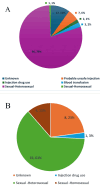Proportion of Late Presenters to HIV Care and Barriers to Early Presentation: A Mixed-Methods Study at a Tertiary Care Hospital in Uttarakhand, India
- PMID: 40390714
- PMCID: PMC12088701
- DOI: 10.7759/cureus.82569
Proportion of Late Presenters to HIV Care and Barriers to Early Presentation: A Mixed-Methods Study at a Tertiary Care Hospital in Uttarakhand, India
Abstract
Introduction: Late presentation to HIV care and delay of people living with HIV (PLHIV) linkage to ART continue to be a challenge in many countries of the world, including India. It has an adverse impact on the health of the patient and the outcome of antiretroviral therapy (ART) programs. In this study, we assessed the proportion of late presenters (LPs), factors associated with late presentation among PLHIV, and barriers to early presentation for HIV care among LPs in a tertiary center in India.
Methodology: A sequential mixed-method study in which the quantitative part was conducted among 156 PLHIV receiving treatment at the ART center of All India Institute of Medical Sciences, Rishikesh, India. It was followed by a qualitative study with in-depth interviews of LPs. Continuous variables such as age and CD4 count were presented as median and interquartile range (IQR) and analyzed using the Mann-Whitney U test. Categorical variables such as gender, marital status, and probable mode of transmission, represented as frequency tables and proportions, were analyzed with Pearson's chi-square test or Fisher's exact test. A framework analysis with the help of social cognitive theory was conducted to analyze the barriers to presenting for HIV care.
Result: The prevalence of late presentation to HIV care was 77.6%. The most probable mode of transmission was sexual contact among early and LPs. Age, marital status, and type of sexual contact were found to be associated with late presentation. The barriers to timely presentation for HIV care were identified as personal, behavioral, and environmental factors, which were interrelated.
Conclusion: Regular testing of HIV in asymptomatic high-risk groups, extensive social and behavioral change communication to improve awareness, and new initiatives to sensitize healthcare professionals to enable them to provide better HIV care are necessary for the timely identification of PLHIV.
Keywords: barriers to care; cd4 t-cells; hiv aids; hiv care; late presentation.
Copyright © 2025, Ajith et al.
Conflict of interest statement
Human subjects: Consent for treatment and open access publication was obtained or waived by all participants in this study. Institutional Ethics Committee, All India Institute of Medical Sciences, Rishikesh issued approval AIIMS/IEC/21/540. Animal subjects: All authors have confirmed that this study did not involve animal subjects or tissue. Conflicts of interest: In compliance with the ICMJE uniform disclosure form, all authors declare the following: Payment/services info: The study was supported by the Indian Council of Medical Research, Government of India, through financial assistance for a postgraduation thesis under Grant No: MD21DEC-0089. Financial relationships: All authors have declared that they have no financial relationships at present or within the previous three years with any organizations that might have an interest in the submitted work. Other relationships: All authors have declared that there are no other relationships or activities that could appear to have influenced the submitted work.
Figures



Similar articles
-
Mixed method approach for determining factors associated with late presentation to HIV/AIDS care in southern India.J Postgrad Med. 2016 Jul-Sep;62(3):173-7. doi: 10.4103/0022-3859.183169. J Postgrad Med. 2016. PMID: 27241809 Free PMC article.
-
Late presenters to HIV care and treatment, identification of associated risk factors in HIV-1 infected Indian population.BMC Public Health. 2010 Jul 13;10:416. doi: 10.1186/1471-2458-10-416. BMC Public Health. 2010. PMID: 20626905 Free PMC article.
-
The association between HIV-related stigma, HIV knowledge and HIV late presenters among people living with HIV (PLHIV) attending public primary care clinic settings in Selangor.PLoS One. 2024 Jul 22;19(7):e0306904. doi: 10.1371/journal.pone.0306904. eCollection 2024. PLoS One. 2024. PMID: 39037975 Free PMC article.
-
HIV Late Presenters in Asia: Management and Public Health Challenges.AIDS Res Treat. 2023 Jun 14;2023:9488051. doi: 10.1155/2023/9488051. eCollection 2023. AIDS Res Treat. 2023. PMID: 37351535 Free PMC article. Review.
-
The latent tuberculosis cascade-of-care among people living with HIV: A systematic review and meta-analysis.PLoS Med. 2021 Sep 7;18(9):e1003703. doi: 10.1371/journal.pmed.1003703. eCollection 2021 Sep. PLoS Med. 2021. PMID: 34492003 Free PMC article.
References
-
- Bandura A. Preventing AIDS. AIDS Prevention and Mental Health. Boston: Springer; 1994. Social cognitive theory and exercise of control over HIV infection; pp. 25–59.
-
- Factors associated with late presentation of HIV and estimation of antiretroviral treatment need according to CD4 lymphocyte count in a resource-limited setting: data from an HIV Cohort Study in India. Alvarez-Uria G, Midde M, Pakam R, Kannan S, Bachu L, Naik PK. Interdiscip Perspect Infect Dis. 2012;2012:293795. - PMC - PubMed
LinkOut - more resources
Full Text Sources
Research Materials
